Comprehensive Analysis: Qualitative and Quantitative Research Methods
VerifiedAdded on 2023/01/12
|6
|1828
|21
Report
AI Summary
This report provides a comprehensive comparison between qualitative and quantitative research methodologies. It explores the fundamental differences in their approaches, including data collection methods, data analysis techniques, and the types of research questions they are best suited to answer. The report highlights the characteristics of qualitative research, such as its focus on in-depth understanding, the use of verbal narratives, and subjective approaches, while also detailing the features of quantitative research, which include numerical data, statistical analysis, and objective measurements. The report further contrasts the two methods across various aspects, including the nature of inquiry, reasoning, sampling techniques, and the types of data gathered. Additionally, it provides insights into the strengths and limitations of each approach, emphasizing their respective applications in business, marketing, psychology, and other fields. Finally, the report references several academic sources to support its analysis.
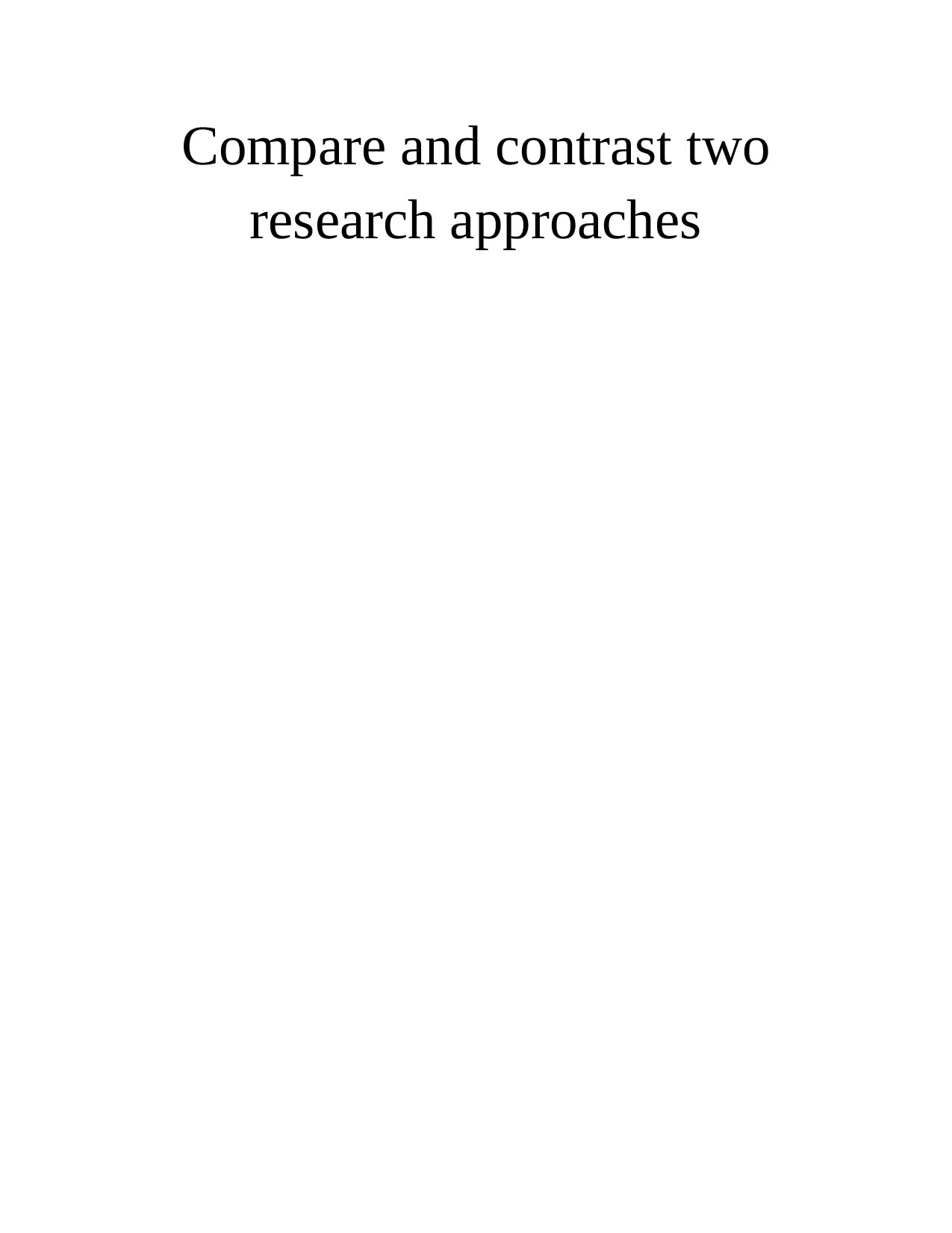
Compare and contrast two
research approaches
research approaches
Paraphrase This Document
Need a fresh take? Get an instant paraphrase of this document with our AI Paraphraser
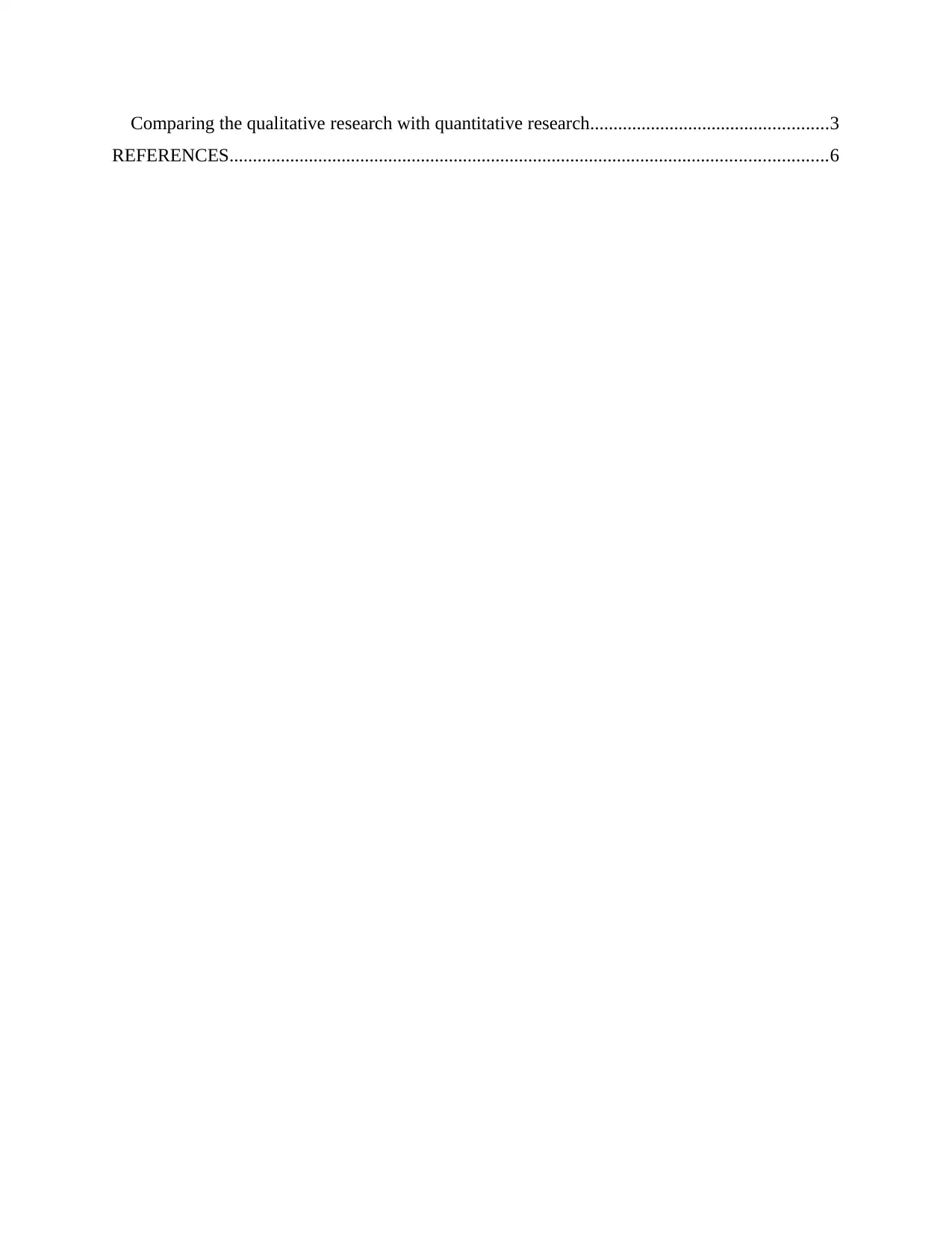
Comparing the qualitative research with quantitative research...................................................3
REFERENCES................................................................................................................................6
REFERENCES................................................................................................................................6
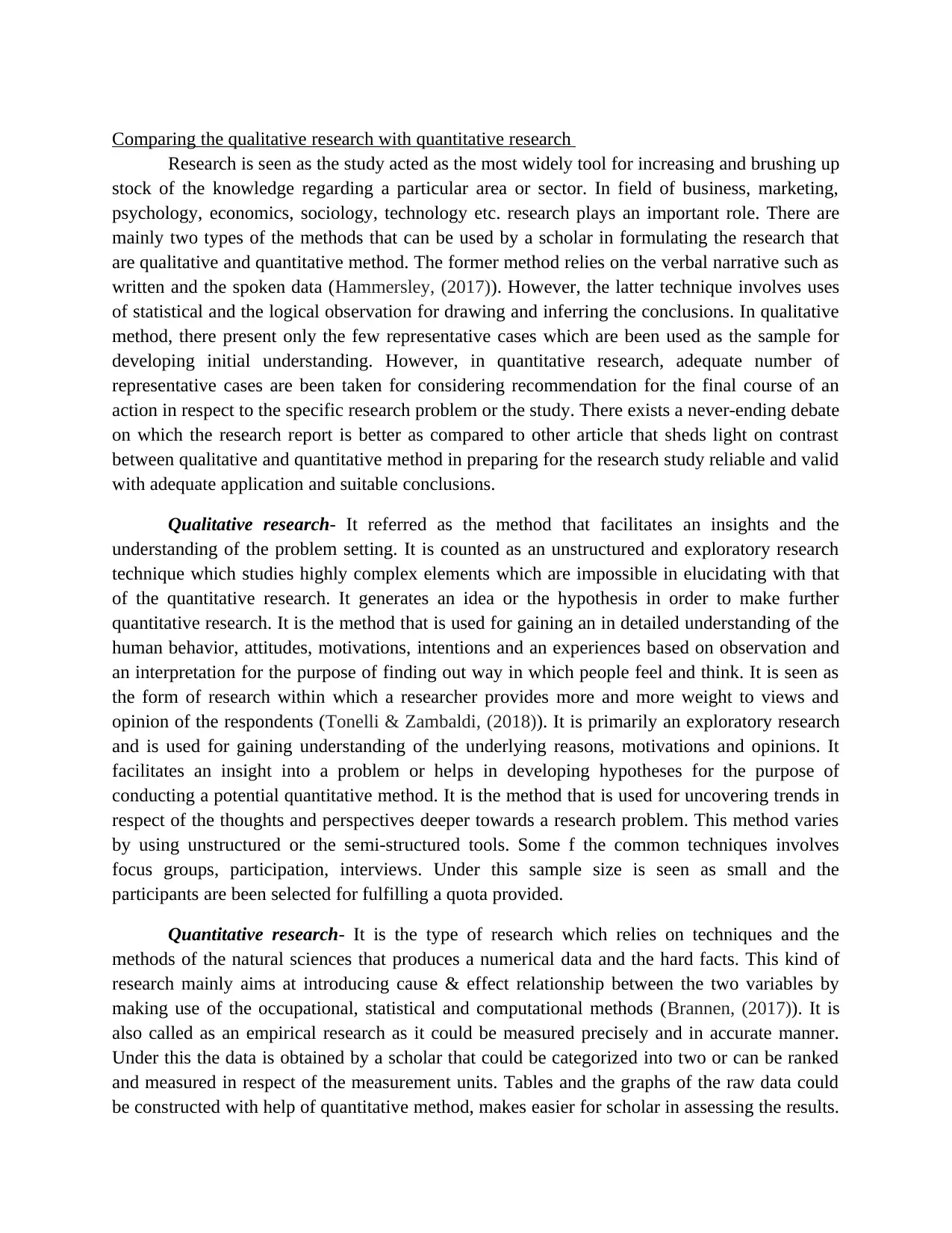
Comparing the qualitative research with quantitative research
Research is seen as the study acted as the most widely tool for increasing and brushing up
stock of the knowledge regarding a particular area or sector. In field of business, marketing,
psychology, economics, sociology, technology etc. research plays an important role. There are
mainly two types of the methods that can be used by a scholar in formulating the research that
are qualitative and quantitative method. The former method relies on the verbal narrative such as
written and the spoken data (Hammersley, (2017)). However, the latter technique involves uses
of statistical and the logical observation for drawing and inferring the conclusions. In qualitative
method, there present only the few representative cases which are been used as the sample for
developing initial understanding. However, in quantitative research, adequate number of
representative cases are been taken for considering recommendation for the final course of an
action in respect to the specific research problem or the study. There exists a never-ending debate
on which the research report is better as compared to other article that sheds light on contrast
between qualitative and quantitative method in preparing for the research study reliable and valid
with adequate application and suitable conclusions.
Qualitative research- It referred as the method that facilitates an insights and the
understanding of the problem setting. It is counted as an unstructured and exploratory research
technique which studies highly complex elements which are impossible in elucidating with that
of the quantitative research. It generates an idea or the hypothesis in order to make further
quantitative research. It is the method that is used for gaining an in detailed understanding of the
human behavior, attitudes, motivations, intentions and an experiences based on observation and
an interpretation for the purpose of finding out way in which people feel and think. It is seen as
the form of research within which a researcher provides more and more weight to views and
opinion of the respondents (Tonelli & Zambaldi, (2018)). It is primarily an exploratory research
and is used for gaining understanding of the underlying reasons, motivations and opinions. It
facilitates an insight into a problem or helps in developing hypotheses for the purpose of
conducting a potential quantitative method. It is the method that is used for uncovering trends in
respect of the thoughts and perspectives deeper towards a research problem. This method varies
by using unstructured or the semi-structured tools. Some f the common techniques involves
focus groups, participation, interviews. Under this sample size is seen as small and the
participants are been selected for fulfilling a quota provided.
Quantitative research- It is the type of research which relies on techniques and the
methods of the natural sciences that produces a numerical data and the hard facts. This kind of
research mainly aims at introducing cause & effect relationship between the two variables by
making use of the occupational, statistical and computational methods (Brannen, (2017)). It is
also called as an empirical research as it could be measured precisely and in accurate manner.
Under this the data is obtained by a scholar that could be categorized into two or can be ranked
and measured in respect of the measurement units. Tables and the graphs of the raw data could
be constructed with help of quantitative method, makes easier for scholar in assessing the results.
Research is seen as the study acted as the most widely tool for increasing and brushing up
stock of the knowledge regarding a particular area or sector. In field of business, marketing,
psychology, economics, sociology, technology etc. research plays an important role. There are
mainly two types of the methods that can be used by a scholar in formulating the research that
are qualitative and quantitative method. The former method relies on the verbal narrative such as
written and the spoken data (Hammersley, (2017)). However, the latter technique involves uses
of statistical and the logical observation for drawing and inferring the conclusions. In qualitative
method, there present only the few representative cases which are been used as the sample for
developing initial understanding. However, in quantitative research, adequate number of
representative cases are been taken for considering recommendation for the final course of an
action in respect to the specific research problem or the study. There exists a never-ending debate
on which the research report is better as compared to other article that sheds light on contrast
between qualitative and quantitative method in preparing for the research study reliable and valid
with adequate application and suitable conclusions.
Qualitative research- It referred as the method that facilitates an insights and the
understanding of the problem setting. It is counted as an unstructured and exploratory research
technique which studies highly complex elements which are impossible in elucidating with that
of the quantitative research. It generates an idea or the hypothesis in order to make further
quantitative research. It is the method that is used for gaining an in detailed understanding of the
human behavior, attitudes, motivations, intentions and an experiences based on observation and
an interpretation for the purpose of finding out way in which people feel and think. It is seen as
the form of research within which a researcher provides more and more weight to views and
opinion of the respondents (Tonelli & Zambaldi, (2018)). It is primarily an exploratory research
and is used for gaining understanding of the underlying reasons, motivations and opinions. It
facilitates an insight into a problem or helps in developing hypotheses for the purpose of
conducting a potential quantitative method. It is the method that is used for uncovering trends in
respect of the thoughts and perspectives deeper towards a research problem. This method varies
by using unstructured or the semi-structured tools. Some f the common techniques involves
focus groups, participation, interviews. Under this sample size is seen as small and the
participants are been selected for fulfilling a quota provided.
Quantitative research- It is the type of research which relies on techniques and the
methods of the natural sciences that produces a numerical data and the hard facts. This kind of
research mainly aims at introducing cause & effect relationship between the two variables by
making use of the occupational, statistical and computational methods (Brannen, (2017)). It is
also called as an empirical research as it could be measured precisely and in accurate manner.
Under this the data is obtained by a scholar that could be categorized into two or can be ranked
and measured in respect of the measurement units. Tables and the graphs of the raw data could
be constructed with help of quantitative method, makes easier for scholar in assessing the results.
⊘ This is a preview!⊘
Do you want full access?
Subscribe today to unlock all pages.

Trusted by 1+ million students worldwide
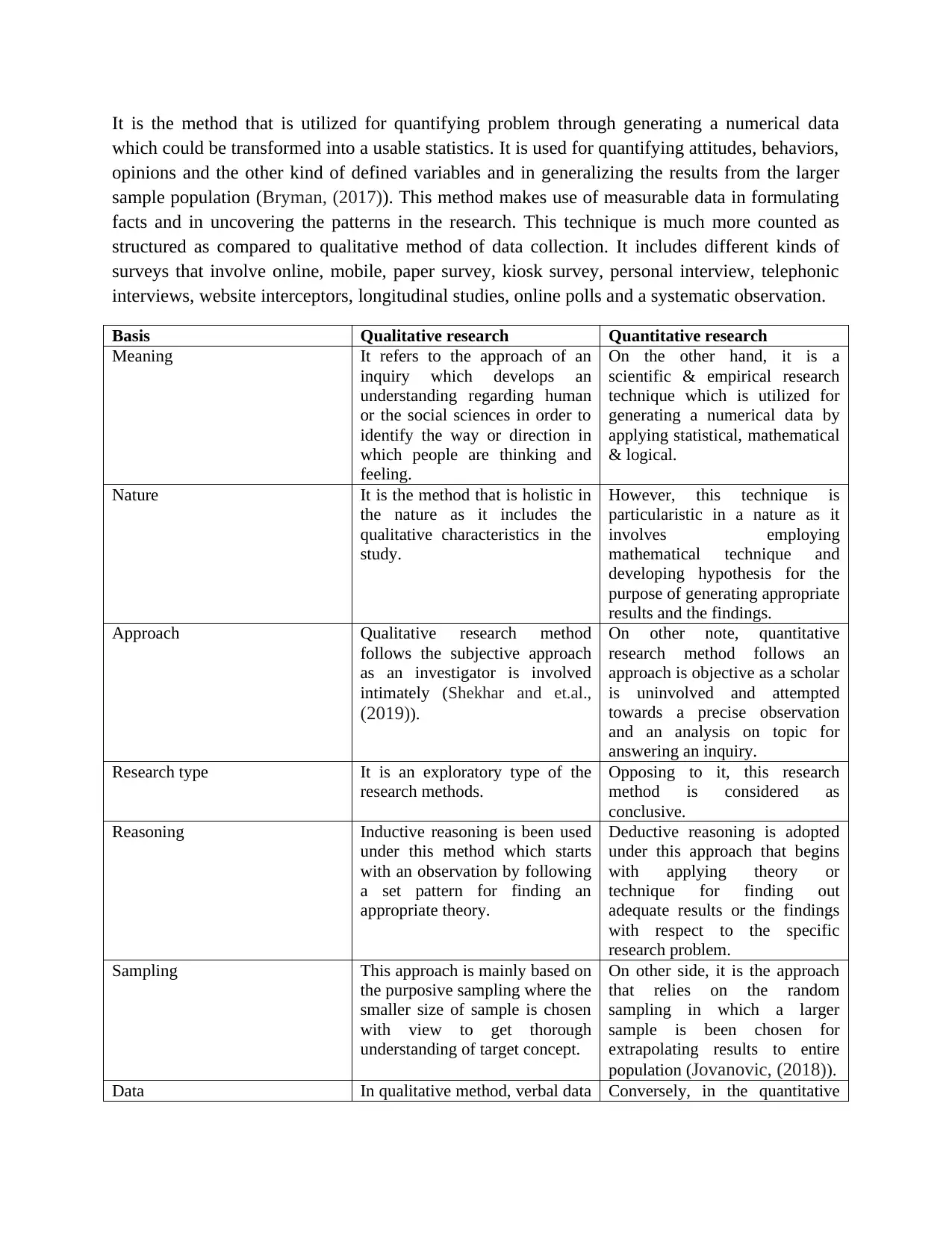
It is the method that is utilized for quantifying problem through generating a numerical data
which could be transformed into a usable statistics. It is used for quantifying attitudes, behaviors,
opinions and the other kind of defined variables and in generalizing the results from the larger
sample population (Bryman, (2017)). This method makes use of measurable data in formulating
facts and in uncovering the patterns in the research. This technique is much more counted as
structured as compared to qualitative method of data collection. It includes different kinds of
surveys that involve online, mobile, paper survey, kiosk survey, personal interview, telephonic
interviews, website interceptors, longitudinal studies, online polls and a systematic observation.
Basis Qualitative research Quantitative research
Meaning It refers to the approach of an
inquiry which develops an
understanding regarding human
or the social sciences in order to
identify the way or direction in
which people are thinking and
feeling.
On the other hand, it is a
scientific & empirical research
technique which is utilized for
generating a numerical data by
applying statistical, mathematical
& logical.
Nature It is the method that is holistic in
the nature as it includes the
qualitative characteristics in the
study.
However, this technique is
particularistic in a nature as it
involves employing
mathematical technique and
developing hypothesis for the
purpose of generating appropriate
results and the findings.
Approach Qualitative research method
follows the subjective approach
as an investigator is involved
intimately (Shekhar and et.al.,
(2019)).
On other note, quantitative
research method follows an
approach is objective as a scholar
is uninvolved and attempted
towards a precise observation
and an analysis on topic for
answering an inquiry.
Research type It is an exploratory type of the
research methods.
Opposing to it, this research
method is considered as
conclusive.
Reasoning Inductive reasoning is been used
under this method which starts
with an observation by following
a set pattern for finding an
appropriate theory.
Deductive reasoning is adopted
under this approach that begins
with applying theory or
technique for finding out
adequate results or the findings
with respect to the specific
research problem.
Sampling This approach is mainly based on
the purposive sampling where the
smaller size of sample is chosen
with view to get thorough
understanding of target concept.
On other side, it is the approach
that relies on the random
sampling in which a larger
sample is been chosen for
extrapolating results to entire
population (Jovanovic, (2018)).
Data In qualitative method, verbal data Conversely, in the quantitative
which could be transformed into a usable statistics. It is used for quantifying attitudes, behaviors,
opinions and the other kind of defined variables and in generalizing the results from the larger
sample population (Bryman, (2017)). This method makes use of measurable data in formulating
facts and in uncovering the patterns in the research. This technique is much more counted as
structured as compared to qualitative method of data collection. It includes different kinds of
surveys that involve online, mobile, paper survey, kiosk survey, personal interview, telephonic
interviews, website interceptors, longitudinal studies, online polls and a systematic observation.
Basis Qualitative research Quantitative research
Meaning It refers to the approach of an
inquiry which develops an
understanding regarding human
or the social sciences in order to
identify the way or direction in
which people are thinking and
feeling.
On the other hand, it is a
scientific & empirical research
technique which is utilized for
generating a numerical data by
applying statistical, mathematical
& logical.
Nature It is the method that is holistic in
the nature as it includes the
qualitative characteristics in the
study.
However, this technique is
particularistic in a nature as it
involves employing
mathematical technique and
developing hypothesis for the
purpose of generating appropriate
results and the findings.
Approach Qualitative research method
follows the subjective approach
as an investigator is involved
intimately (Shekhar and et.al.,
(2019)).
On other note, quantitative
research method follows an
approach is objective as a scholar
is uninvolved and attempted
towards a precise observation
and an analysis on topic for
answering an inquiry.
Research type It is an exploratory type of the
research methods.
Opposing to it, this research
method is considered as
conclusive.
Reasoning Inductive reasoning is been used
under this method which starts
with an observation by following
a set pattern for finding an
appropriate theory.
Deductive reasoning is adopted
under this approach that begins
with applying theory or
technique for finding out
adequate results or the findings
with respect to the specific
research problem.
Sampling This approach is mainly based on
the purposive sampling where the
smaller size of sample is chosen
with view to get thorough
understanding of target concept.
On other side, it is the approach
that relies on the random
sampling in which a larger
sample is been chosen for
extrapolating results to entire
population (Jovanovic, (2018)).
Data In qualitative method, verbal data Conversely, in the quantitative
Paraphrase This Document
Need a fresh take? Get an instant paraphrase of this document with our AI Paraphraser
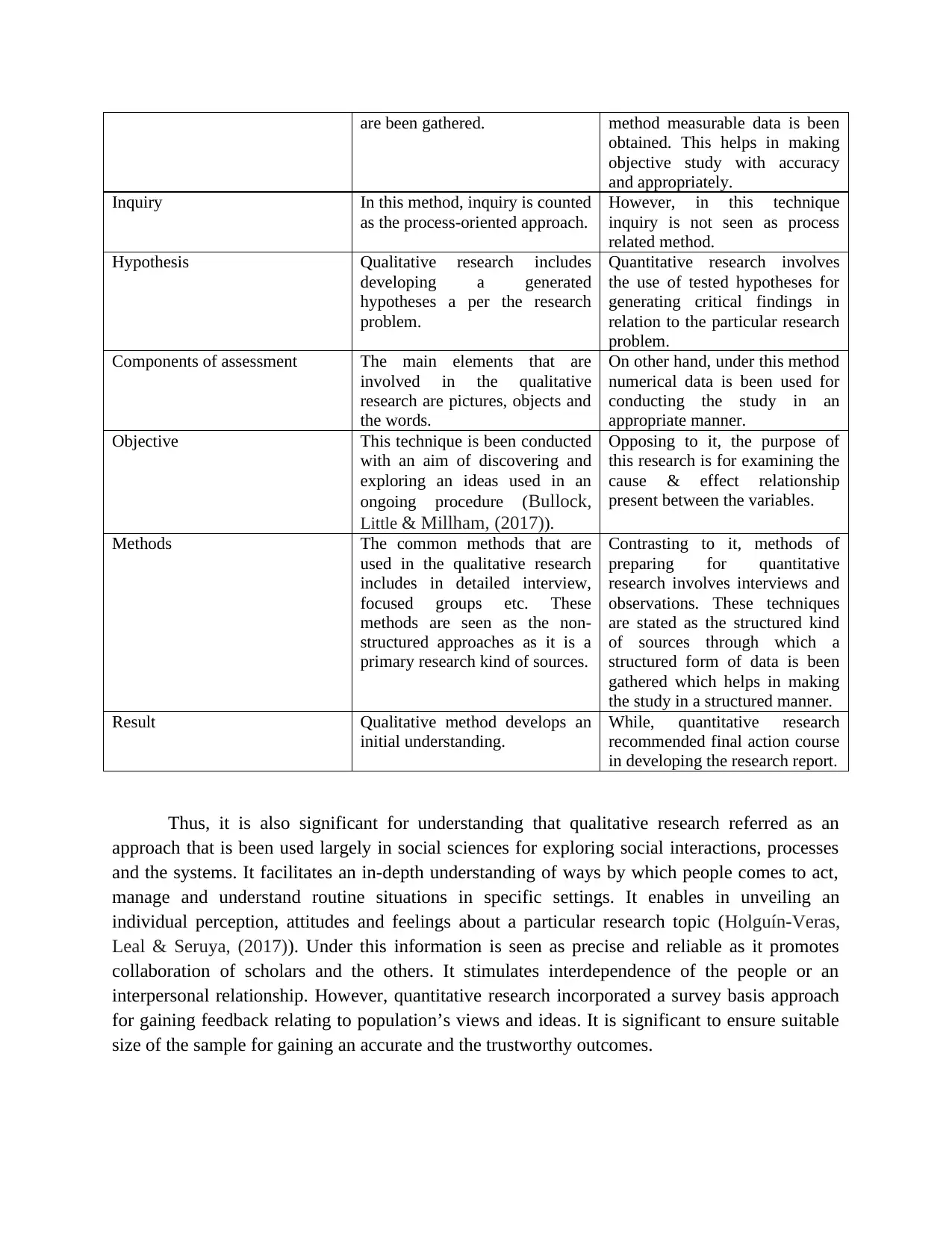
are been gathered. method measurable data is been
obtained. This helps in making
objective study with accuracy
and appropriately.
Inquiry In this method, inquiry is counted
as the process-oriented approach.
However, in this technique
inquiry is not seen as process
related method.
Hypothesis Qualitative research includes
developing a generated
hypotheses a per the research
problem.
Quantitative research involves
the use of tested hypotheses for
generating critical findings in
relation to the particular research
problem.
Components of assessment The main elements that are
involved in the qualitative
research are pictures, objects and
the words.
On other hand, under this method
numerical data is been used for
conducting the study in an
appropriate manner.
Objective This technique is been conducted
with an aim of discovering and
exploring an ideas used in an
ongoing procedure (Bullock,
Little & Millham, (2017)).
Opposing to it, the purpose of
this research is for examining the
cause & effect relationship
present between the variables.
Methods The common methods that are
used in the qualitative research
includes in detailed interview,
focused groups etc. These
methods are seen as the non-
structured approaches as it is a
primary research kind of sources.
Contrasting to it, methods of
preparing for quantitative
research involves interviews and
observations. These techniques
are stated as the structured kind
of sources through which a
structured form of data is been
gathered which helps in making
the study in a structured manner.
Result Qualitative method develops an
initial understanding.
While, quantitative research
recommended final action course
in developing the research report.
Thus, it is also significant for understanding that qualitative research referred as an
approach that is been used largely in social sciences for exploring social interactions, processes
and the systems. It facilitates an in-depth understanding of ways by which people comes to act,
manage and understand routine situations in specific settings. It enables in unveiling an
individual perception, attitudes and feelings about a particular research topic (Holguín-Veras,
Leal & Seruya, (2017)). Under this information is seen as precise and reliable as it promotes
collaboration of scholars and the others. It stimulates interdependence of the people or an
interpersonal relationship. However, quantitative research incorporated a survey basis approach
for gaining feedback relating to population’s views and ideas. It is significant to ensure suitable
size of the sample for gaining an accurate and the trustworthy outcomes.
obtained. This helps in making
objective study with accuracy
and appropriately.
Inquiry In this method, inquiry is counted
as the process-oriented approach.
However, in this technique
inquiry is not seen as process
related method.
Hypothesis Qualitative research includes
developing a generated
hypotheses a per the research
problem.
Quantitative research involves
the use of tested hypotheses for
generating critical findings in
relation to the particular research
problem.
Components of assessment The main elements that are
involved in the qualitative
research are pictures, objects and
the words.
On other hand, under this method
numerical data is been used for
conducting the study in an
appropriate manner.
Objective This technique is been conducted
with an aim of discovering and
exploring an ideas used in an
ongoing procedure (Bullock,
Little & Millham, (2017)).
Opposing to it, the purpose of
this research is for examining the
cause & effect relationship
present between the variables.
Methods The common methods that are
used in the qualitative research
includes in detailed interview,
focused groups etc. These
methods are seen as the non-
structured approaches as it is a
primary research kind of sources.
Contrasting to it, methods of
preparing for quantitative
research involves interviews and
observations. These techniques
are stated as the structured kind
of sources through which a
structured form of data is been
gathered which helps in making
the study in a structured manner.
Result Qualitative method develops an
initial understanding.
While, quantitative research
recommended final action course
in developing the research report.
Thus, it is also significant for understanding that qualitative research referred as an
approach that is been used largely in social sciences for exploring social interactions, processes
and the systems. It facilitates an in-depth understanding of ways by which people comes to act,
manage and understand routine situations in specific settings. It enables in unveiling an
individual perception, attitudes and feelings about a particular research topic (Holguín-Veras,
Leal & Seruya, (2017)). Under this information is seen as precise and reliable as it promotes
collaboration of scholars and the others. It stimulates interdependence of the people or an
interpersonal relationship. However, quantitative research incorporated a survey basis approach
for gaining feedback relating to population’s views and ideas. It is significant to ensure suitable
size of the sample for gaining an accurate and the trustworthy outcomes.
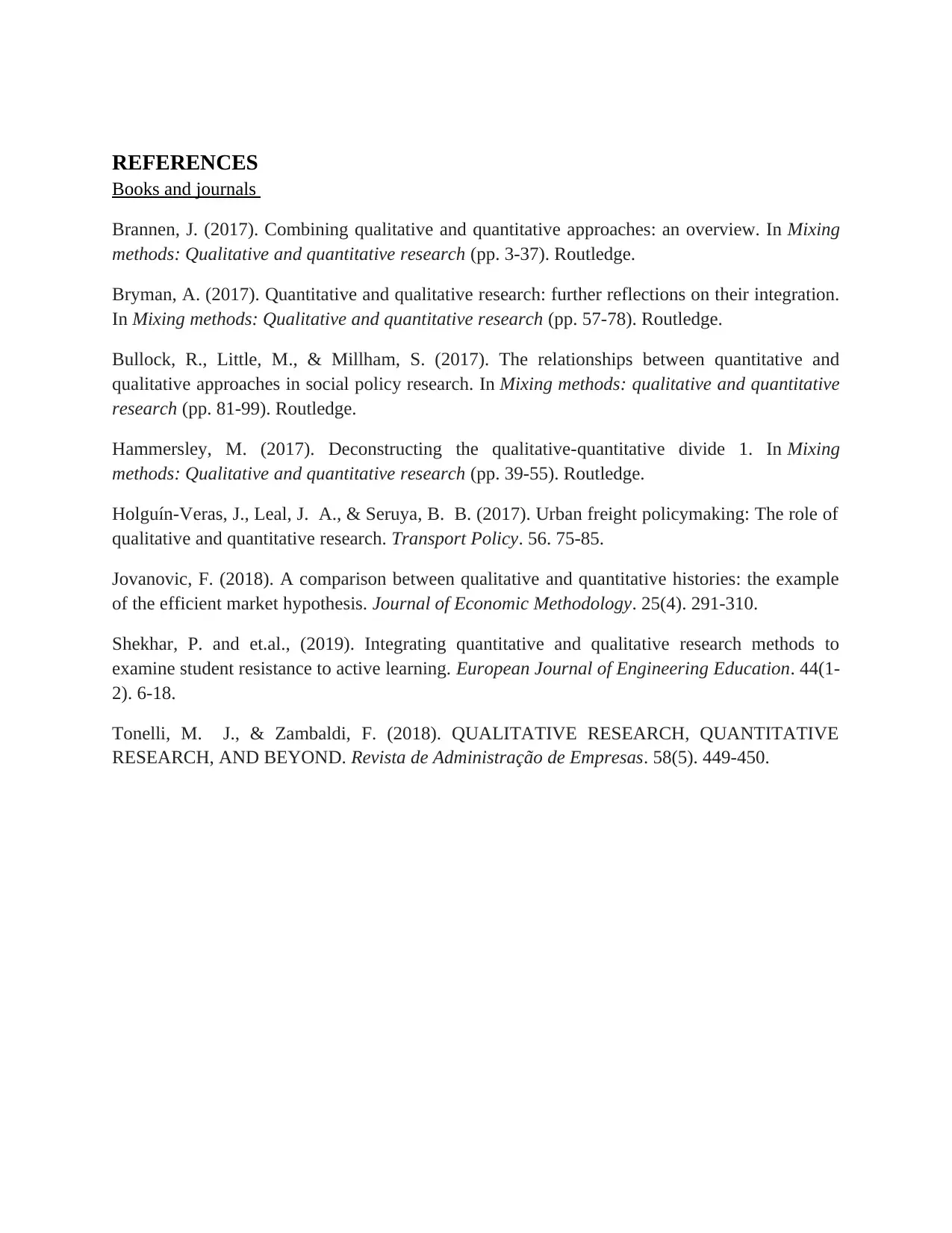
REFERENCES
Books and journals
Brannen, J. (2017). Combining qualitative and quantitative approaches: an overview. In Mixing
methods: Qualitative and quantitative research (pp. 3-37). Routledge.
Bryman, A. (2017). Quantitative and qualitative research: further reflections on their integration.
In Mixing methods: Qualitative and quantitative research (pp. 57-78). Routledge.
Bullock, R., Little, M., & Millham, S. (2017). The relationships between quantitative and
qualitative approaches in social policy research. In Mixing methods: qualitative and quantitative
research (pp. 81-99). Routledge.
Hammersley, M. (2017). Deconstructing the qualitative-quantitative divide 1. In Mixing
methods: Qualitative and quantitative research (pp. 39-55). Routledge.
Holguín-Veras, J., Leal, J. A., & Seruya, B. B. (2017). Urban freight policymaking: The role of
qualitative and quantitative research. Transport Policy. 56. 75-85.
Jovanovic, F. (2018). A comparison between qualitative and quantitative histories: the example
of the efficient market hypothesis. Journal of Economic Methodology. 25(4). 291-310.
Shekhar, P. and et.al., (2019). Integrating quantitative and qualitative research methods to
examine student resistance to active learning. European Journal of Engineering Education. 44(1-
2). 6-18.
Tonelli, M. J., & Zambaldi, F. (2018). QUALITATIVE RESEARCH, QUANTITATIVE
RESEARCH, AND BEYOND. Revista de Administração de Empresas. 58(5). 449-450.
Books and journals
Brannen, J. (2017). Combining qualitative and quantitative approaches: an overview. In Mixing
methods: Qualitative and quantitative research (pp. 3-37). Routledge.
Bryman, A. (2017). Quantitative and qualitative research: further reflections on their integration.
In Mixing methods: Qualitative and quantitative research (pp. 57-78). Routledge.
Bullock, R., Little, M., & Millham, S. (2017). The relationships between quantitative and
qualitative approaches in social policy research. In Mixing methods: qualitative and quantitative
research (pp. 81-99). Routledge.
Hammersley, M. (2017). Deconstructing the qualitative-quantitative divide 1. In Mixing
methods: Qualitative and quantitative research (pp. 39-55). Routledge.
Holguín-Veras, J., Leal, J. A., & Seruya, B. B. (2017). Urban freight policymaking: The role of
qualitative and quantitative research. Transport Policy. 56. 75-85.
Jovanovic, F. (2018). A comparison between qualitative and quantitative histories: the example
of the efficient market hypothesis. Journal of Economic Methodology. 25(4). 291-310.
Shekhar, P. and et.al., (2019). Integrating quantitative and qualitative research methods to
examine student resistance to active learning. European Journal of Engineering Education. 44(1-
2). 6-18.
Tonelli, M. J., & Zambaldi, F. (2018). QUALITATIVE RESEARCH, QUANTITATIVE
RESEARCH, AND BEYOND. Revista de Administração de Empresas. 58(5). 449-450.
⊘ This is a preview!⊘
Do you want full access?
Subscribe today to unlock all pages.

Trusted by 1+ million students worldwide
1 out of 6
Related Documents
Your All-in-One AI-Powered Toolkit for Academic Success.
+13062052269
info@desklib.com
Available 24*7 on WhatsApp / Email
![[object Object]](/_next/static/media/star-bottom.7253800d.svg)
Unlock your academic potential
Copyright © 2020–2025 A2Z Services. All Rights Reserved. Developed and managed by ZUCOL.





